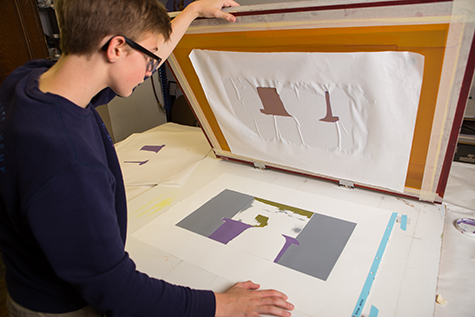The Necessary Guide to Comprehending Screen Printing and Its Versatile Makes use of
Screen printing has an abundant background that goes back to ancient times, advancing right into an advanced strategy utilized throughout numerous markets today. This overview explores the ins and outs of the screen printing process, detailing its applications in home, style, and advertising and marketing décor - 10:9 Design reviews. Understanding these basics can open imaginative possibility for both business and artistic jobs. The following sections will expose essential pointers and techniques to boost one's screen printing ventures
The Background of Screen Printing
Screen printing has roots that map back centuries, its development mirrors the artistic and technical developments of numerous societies. Coming from ancient China, the method was at first utilized for embellishing textiles and later spread to Japan, where it ended up being important to Ukiyo-e woodblock printing. The technique shifted to Europe in the 18th century, where it gained popularity among craftsmens and industrial printers. The innovation of photo solution in the 20th century changed screen printing, permitting more detailed layouts and greater efficiency. Artists like Andy Warhol better thrust its popularity, using the tool to produce iconic jobs that combined commercialism and art. By the late 20th century, screen printing had actually developed itself as a functional technique, used in vogue, advertising, and art. Today, it proceeds to progress, incorporating electronic technology and increasing its applications throughout numerous markets.
The Screen Printing Refine Explained
Screen printing transforms artistic visions into concrete styles with a collection of exact actions. A photo is produced and then moved onto a screen, commonly made of great mesh textile stretched over a framework. A light-sensitive emulsion is put on the screen, which is subjected to light, hardening in areas not covered by the picture. After washing out the unhardened solution, a stencil is created.
Next, the screen is placed over the substrate, whether it be textile, paper, or another product. Ink is then pushed through the open locations of the stencil using a squeegee, depositing the style onto the substratum below. This procedure can be repeated for numerous colors, needing separate screens for each tone. Ultimately, the published product is healed making use of warm to assure the ink sticks properly, leading to a durable, lively design on-line.
Sorts Of Screen Printing Techniques

In addition, specialty techniques, such as discharge screen printing, remove dye from the fabric to produce softer prints, while foil screen printing uses metallic aluminum foil to achieve a shiny coating (10:9 Design Texas). Each strategy provides distinct characteristics, accommodating numerous creative needs and production scales, ultimately expanding the opportunities within the screen printing domain
Applications of Screen Printing in Different Industries

Furthermore, the signs and marketing industries make use of screen printing for developing attractive display screens and banners. This technique permits view it now for bold colors and intricate styles that capture attention. In electronic devices, screen printing is employed for applying conductive inks to motherboard, vital for part links. Additionally, the home decoration industry welcomes screen printing to generate distinct layouts on textiles and wall art. On the whole, screen printing offers as an essential device across varied areas, boosting products with personalized and visually enticing graphics.
Tips for Effective Screen Printing Projects
While taking on a screen printing task, cautious attention to information can significantly boost the final end result. Initially, choosing top notch products is important; this consists of the screen, inks, and substratums. Using appropriate mesh matters can affect ink deposition and detail resolution. Prep work is similarly essential; comprehensive cleansing of displays and correct exposure times guarantee crisp prints.
Next off, exact registration is critical for multi-color prints. Using placement tools can aid accomplish specific layering. Furthermore, screening prints on scrap materials prior to production assists recognize prospective concerns without throwing away resources.

Frequently Asked Questions
What Materials Are Finest for Screen Printing on Material?
Cotton and polyester blends are optimal for screen printing on material due to their toughness and ink absorption. In addition, specialty fabrics like silk or canvas can produce distinct structures and coatings, boosting the total style high quality.
Exactly how Do I Clean and Maintain Screen Printing Tools?
To preserve and cleanse screen printing devices, one must consistently clean screens with proper solvents, evaluate mops for wear, lubricate relocating parts, and shop all products in a completely dry, dust-free environment to prolong their life-span.
What Are the Ecological Impacts of Screen Printing?
Screen printing can have considerable environmental influences, including chemical waste from solvents and inks, water usage throughout cleaning procedures, and energy usage. Sustainable methods and environment-friendly products are important for reducing these adverse impacts.
Can Screen Printing Be Done in the house Properly?
Screen printing can be efficiently done at home with the best products and techniques. Hobbyists can produce high quality prints, though success relies on their ability level, equipment, and understanding of the procedure entailed.
What Are the Expenses Related To Starting a Screen Printing Service?

Beginning a screen printing service includes costs for equipment, products, and work area. Preliminary expenses typically vary from a couple of hundred to several thousand dollars, depending upon the scale, quality of equipment, and wanted manufacturing ability.
Screen printing has a rich background that dates back to old times, evolving right into an innovative technique utilized across different signs and banners made near me markets today. One more method, rotary screen printing, utilizes round screens, assisting in constant printing on fabric rolls, Look At This therefore boosting efficiency for large-scale manufacturings. Additionally, specialty strategies, such as discharge screen printing, get rid of dye from the textile to produce softer prints, while aluminum foil screen printing applies metal aluminum foil to accomplish a glossy finish. In the style field, screen printing is extensively utilized to produce dynamic styles on apparel, making it possible for brand names to display their one-of-a-kind styles. Cotton and polyester blends are ideal for screen printing on textile due to their longevity and ink absorption.